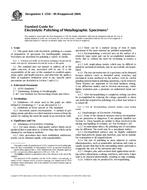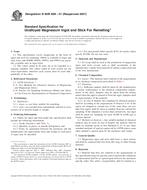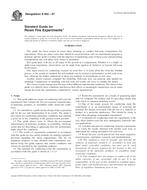1.1 Purpose and Application:
1.1.1 This guide summarizes the equipment, field procedures, and interpretation methods for the assessment of subsurface conditions using the frequency domain electromagnetic (FDEM) method.
1.1.2 FDEM measurements as described in this standard guide are applicable to mapping subsurface conditions for geologic, geotechnical, hydrologic, environmental, agricultural, archaeological and forensic investigations as well as mineral exploration.
1.1.3 The FDEM method is sometimes used to map such diverse geologic conditions as depth to bedrock, fractures and fault zones, voids and sinkholes, soil and rock properties, and saline intrusion as well as man-induced environmental conditions including buried drums, underground storage tanks (USTs), landfill boundaries and conductive ground water contamination.
1.1.4 The FDEM method utilizes the secondary magnetic field induced in the earth by a time-varying primary magnetic field to explore the subsurface. It measures the amplitude and phase of the induced field at various frequencies. FDEM measurements therefore are dependent on the electrical properties of the subsurface soil and rock or buried man-made objects as well as the orientation of any subsurface geological features or man-made objects. In many cases, the FDEM measurements can be used to identify the subsurface structure or object. This method is used only when it is expected that the subsurface soil or rock, man-made materials or geologic structure can be characterized by differences in electrical conductivity.
1.1.5 The FDEM method may be used instead of the Direct Current Resistivity method (Guide D 6431) when surface soils are excessively insulating (for example, dry or frozen) or a layer of asphalt or plastic or other logistical constraints prevent electrode to soil contact.
1.2 Limitations:
1.2.1 This standard guide provides an overview of the FDEM method using coplanar coils at or near ground level and has been referred to by other names including Slingram, HLEM (horizontal loop electromagnetic) and Ground Conductivity methods. This guide does not address the details of the electromagnetic theory, field procedures or interpretation of the data. References are included that cover these aspects in greater detail and are considered an essential part of this guide (Grant and West, 1965; Wait, 1982; Kearey and Brook, 1991; Milsom, 1996; Ward, 1990). It is recommended that the user of the FDEM method review the relevant material pertaining to their particular application. ASTM standards that should also be consulted include Guide D 420, Terminology D 653, Guide D 5730, Guide D 5753, Practice D 6235, Guide D 6429, and Guide D 6431.
1.2.2 This guide is limited to frequency domain instruments using a coplanar orientation of the transmitting and receiving coils in either the horizontal dipole (HD) mode with coils vertical, or the vertical dipole (VD) mode with coils horizontal (Fig. 2). It does not include coaxial or asymmetrical coil orientations, which are sometimes used for special applications (Grant and West 1965).
1.2.3 This guide is limited to the use of frequency domain instruments in which the ratio of the induced secondary magnetic field to the primary magnetic field is directly proportional to the ground’s bulk or apparent conductivity (see 5.1.4). Instruments that give a direct measurement of the apparent ground conductivity are commonly referred to as Ground Conductivity Meters (GCMs) that are designed to operate within the “low induction number approximation.“ Multi-frequency instruments operating within and outside the low induction number approximation provide the ratio of the secondary to primary magnetic field, which can be used to calculate the ground conductivity.
1.2.4 The FDEM (inductive) method has been adapted for a number of special uses within a borehole, on water, or airborne. Discussions of these adaptations or methods are not included in this guide.
1.2.5 The approaches suggested in this guide for the frequency domain method are the most commonly used, widely accepted and proven; however other lesser-known or specialized techniques may be substituted if technically sound and documented.
1.2.6 Technical limitations and cultural interferences that restrict or limit the use of the frequency domain method are discussed in section 5.4.
1.2.7 This guide offers an organized collection of information or a series of options and does not recommend a specific course of action. This document cannot replace education, experience, and professional judgment. Not all aspects of this guide may be applicable in all circumstances. This ASTM standard is not intended to represent or replace the standard of care by which the adequacy of a given professional service must be judged without consideration of a project’s many unique aspects. The word standard in the title of this document means that the document has been approved through the ASTM consensus process.
1.3 Precautions:
1.3.1 If the method is used at sites with hazardous materials, operations, or equipment, it is the responsibility of the user of this guide to establish appropriate safety and health practices and to determine the applicability of regulations prior to use.
1.3.2 This standard guide does not purport to address all of the safety concerns that may be associated with its use. It is the responsibility of the user of this standard guide to determine the applicability of regulations prior to use.

FIG. 1 Principles of Electromagnetic Induction in Ground Conductivity Measurements (Sheriff, 1989)

FIG. 2 Relative Response of Horizontal and Vertical Dipole Coil Orientations (McNeill, 1980)
Product Details
- Published:
- 12/01/2008
- Number of Pages:
- 14
- File Size:
- 1 file , 310 KB


